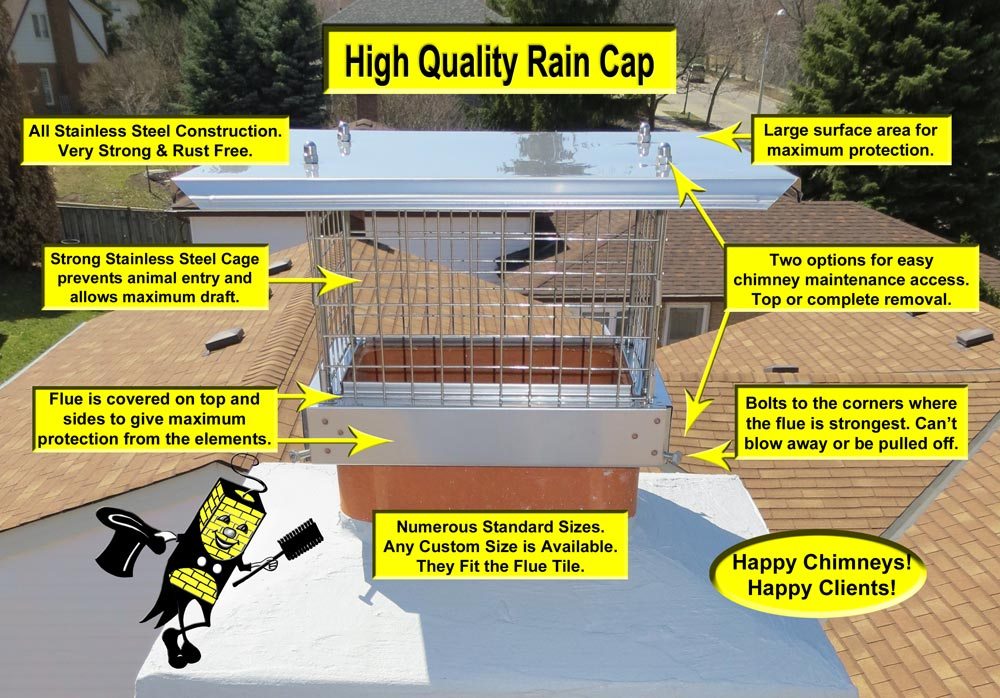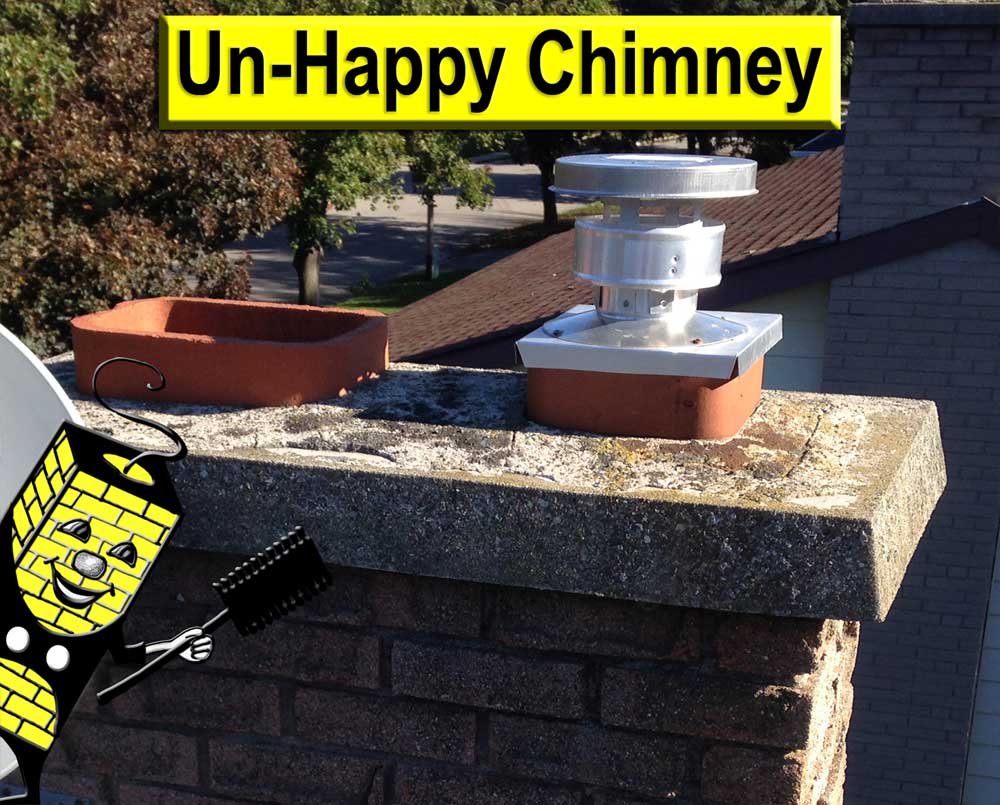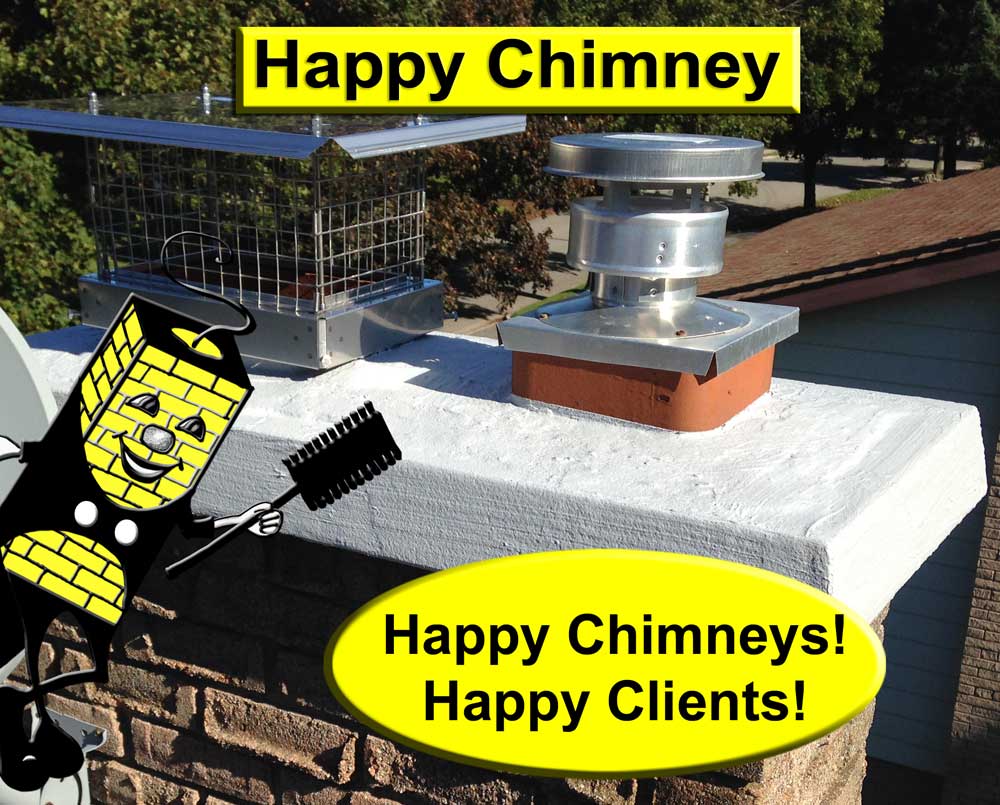What Does a Rain Cap Do?
Raincaps perform 2 basic functions and should do them well.
- They keep rain and snow out of the chimney and away from the area around the top flue tile.
- Rain and snow account for a large amount of water entering the chimney. In Waterloo Region the average annual precipitation means that 10 to 15 gallons of water are going down the chimney. Each flue is like having an 8 x 12 inch hole in your roof. Imagine that in your living room during the next thunderstorm.
- The water soaks the inside of the chimney as well as the fireplace and foundation at the bottom. The soaked flue tiles and bricks rot from the inside and spall apart without you being aware of the problem.
- It also causes mold and mildew anywhere it gets the chance to start
- They keep birds, squirrels, raccoon, and any other critters from nesting in the chimney.
- Birds, squirrels, and raccoons love nesting in chimneys. For them, a chimney is just like a hollow tree. Cozy, warm, and safe with one easy to defend entrance.
- They live inside, use it for a toilet, have babies, are noisy, plug the chimney with debris, sometimes get into the house, and quite often die in the chimney or above the fireplace damper.
- It result smells horrible, attracts fleas, flies, and other unpleasant insects, and is a huge mess.
- The nesting material stays wet and contributes greatly to mold, and water damage to everything around the chimney.
- Cleaning the critters out is expensive and messy.

Call or Email today to have a High Quality Rain Cap Installed
What Is A High Quality Raincap?
- It should be made from Stainless Steel to prevent rust.
- Rust makes the cap look bad, runs down the chimney and stains the bricks.
- Rust eventually destroys the cap, critters and rain get in, and another cap needs to be purchased and installed.Our Raincaps are manufactured from high quality stainless steel.
- It should bolt on to the corners of the flue tile.
- Bolts provide maximum holding power at the strongest points of the flue tile.
- If it just has legs inside the flue, or some other friction system to hold it on, wind can blow it off and animals can pull it off.
- The bolts need to be in the corner of the flue tile where it is strongest. Some companies have bolts that attach to the middle of the flue tile – the weakest point. If you tighten the bolts a bit too much the flue tile cracks right down the middle. If you don’t tighten them quite enough the cap blows off.Our raincaps bolt on at the corners.
- The top of the raincap should have a large surface area to deflect as much rain as possible.
- More surface area protects a larger area of the chimney crown and keeps everything dryer
- Rain doesn’t always fall straight down. A larger lid means that when rain is coming from an angle, more is deflected and less goes down the chimney.Our raincaps have lids with very large surface area.
- There needs to be a very strong screen that keeps critters out, but provides maximum draft and air flow, and will not easily clog with creosote.
- Light screen is easily pushed aside by critters, so something stronger is needed.
- Screen with small diameter holes frequently clogs with creosote causing smoke to back up into the house.
- Stamped steel cages are strong and keep animals out, but can sometimes decrease draft.Our Raincaps have a cage made from large gage welded stainless wire. They are very strong, with the hole diameter sized to keep any critters out, while at the same time, maximizing draft and minimizing the potential for creosote buildup.
- The base of the raincap should protect the top of the flue tile.
- Flue tiles spall and break apart from water and frost damage just like any other masonry. A raincap should provide as much protections as possible.
- Leg style raincaps and most other styles provide little or no protection for the flue tile.Our Raincaps have a full flange that covers the top surface of the flue tile as well as the sides for a couple of inches down.
- The Raincap should be easy to remove for sweeping or any other purpose.
- Easy to remove intentionally, but otherwise well attached. That’s the hard part.
- Many that are well attached end up with rusted bolts etc. that make them almost impossible to remove.
- Many that are easy to remove for cleaning are also easily removed by animals or a strong wind.Our Raincaps can be removed in 2 different ways for cleaning. The bolts are stainless and never rust so it is easily removed and reinstalled. Also, the lid is attached with stainless lug nuts so in some situations it is convenient to just remove the top for cleaning.
- The raincap should fit well.
- When raincaps don’t fit, they don’t work.
- One size fits all often means one size fits none well.
- Too small and they sit high so birds and animals can enter underneath or around the edge.
- Too large and they put excessive pressure on the flue tile from the inside and crack it.
- We have seen round raincaps hammered into square flues, rectangles into squares, squares into round, and pretty much every other conceivable option. Why? We do not know.Our raincaps are the right size for the flue. They are manufactured in a wide variety of standard shapes and sizes and can be custom made to any size almost immediately. We install the proper size.
Dig Deeper
Want to learn more about Rain Caps and why they are important? Click on the links below to learn more!
Happy Chimneys
We love making chimneys happy again. Drag the yellow box below the image to see how we make an un-happy chimney happy again.


